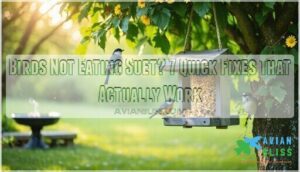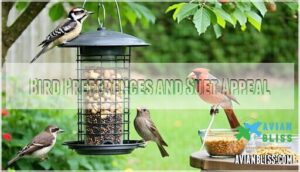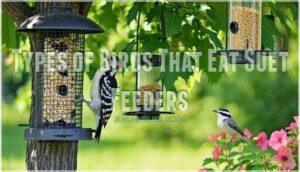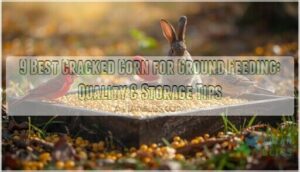This site is supported by our readers. We may earn a commission, at no cost to you, if you purchase through links.
 If birds aren’t eating your suet, you’re probably dealing with stale or melted fat, poor feeder placement, or accessibility issues.
If birds aren’t eating your suet, you’re probably dealing with stale or melted fat, poor feeder placement, or accessibility issues.
Fresh suet should feel firm and smell neutral—rancid suet drives birds away faster than a cat at a bird convention.
Check if your feeder’s positioned near natural cover but visible to passing birds.
Temperature matters too; summer heat turns quality suet into an unappetizing mess.
Sometimes patience is key—new feeders can take weeks for birds to discover.
The specific type of suet and your local bird species preferences play vital roles in attracting those feathered visitors you’re hoping to see, and understanding these preferences requires local knowledge.
Table Of Contents
- Key Takeaways
- Reasons Birds May Not Eat Suet
- Suet Quality and Temperature
- Suet Recipe
- Tips for Attracting Birds to Suet
- Feeder Placement and Bird Discovery
- Bird Preferences and Suet Appeal
- Suet Accessibility and Freshness
- Types of Birds That Eat Suet Feeders
- Factors Affecting Birds’ Suet Consumption
- Suet Feeding Considerations Throughout The Year
- Frequently Asked Questions (FAQs)
- How do I get birds to come to my suet feeder?
- What time of year do birds eat suet?
- How to get birds to eat suet cake?
- Can you put a suet in a bird feeder?
- Why are my birds not finding my suet feeder?
- What birds eat suet feeders?
- Why do birds not eat suet?
- Why are birds not eating suet?
- How do you get birds to eat suet?
- How long does it take for birds to find a suet feeder?
- Conclusion
Key Takeaways
- Check your suet’s freshness – you’ll repel birds faster than attract them if your suet smells rancid, feels gooey, or shows signs of mold, so replace it immediately when temperatures exceed 75°F.
- Position feeders strategically – place them 5-6 feet high near trees or shrubs for cover, ensuring they’re visible to passing birds while providing safe escape routes from predators.
- Be patient with new feeders – birds can take several weeks to discover new food sources, so don’t give up if you don’t see immediate activity at your freshly installed suet feeder.
- Match suet types to local species – woodpeckers prefer pure fat suet, while nuthatches enjoy varieties mixed with insects, so experiment with different formulations if you’re not attracting your target birds.
Reasons Birds May Not Eat Suet
When your suet feeder sits untouched, you’re likely dealing with one of three main culprits: poor feeder placement, spoiled suet, or the wrong bird species in your area.
Most feeding problems stem from feeders placed in unsafe locations, stale suet that’s turned rancid, or simply not having suet-eating birds like woodpeckers and nuthatches nearby.
Feeder Accessibility
Your backyard’s bird traffic jam might be due to feeder accessibility issues.
Birds need easy access, so consider these bird feeder placement tips:
- Place feeders in open, visible spots for maximum Bird Visibility.
- Adjust Suet Height—5-6 feet is ideal for most species.
- Use Feeder Design that deters predators and unwanted guests.
Proper suet feeder maintenance boosts accessibility factors!
Understanding suet feeder types is vital for attracting various bird species, which can be achieved with the right suet feeder maintenance.
Suet Quality
Fresh suet quality determines whether birds visit your feeder.
Suet spoilage occurs when fat turns rancid, develops mold, or melts in warm weather—creating an unappealing mess birds won’t touch.
Proper suet storage in cool, shaded areas prevents deterioration and maintains suet freshness.
Check suet texture regularly for discoloration or strong odors.
Quality suet rendering and premium suet ingredients guarantee maximum suet appeal to hungry birds.
Bird Preferences
Your feathered visitors aren’t picky eaters—they’re specialists with specific dietary needs. Different bird species have distinct feeding habits and beak sizes that determine their suet preferences.
Woodpeckers love pure fat suet, while nuthatches prefer varieties mixed with seeds.
If birds not eating suet persists, try switching suet types or adding insects to match local bird feeding preferences and attract more species.
Suet Quality and Temperature
Temperature changes can turn your fresh suet into a bird-repelling mess faster than you’d expect.
When suet gets too warm, it becomes gooey and spoils quickly, while freezing temperatures make it rock-hard and impossible for birds to access, which can render the suet useless, making it a gooey mess.
Spoilage and Deterioration
When suet spoils above 80°F, bacterial growth and fungal contamination create rancid suet that repels birds completely.
Suet mold appears as discolored patches, while suet spoilage produces sour odors that signal fat breakdown.
You’ll notice birds not eating suet when deterioration begins—they’ll abandon feeders entirely rather than risk contaminated food that’s lost nutritional value.
Effects of Spoiled Suet and Gooey Suet
When spoiled or gooey suet sits in your feeder, you’re basically serving birds a health hazard that’ll send them packing faster than a hawk sighting.
Suet spoilage occurs when bacterial contamination and mold growth transform your well-intentioned offering into something that repels rather than attracts.
Here’s what happens when suet goes bad:
- Rancid suet develops a sharp, unpleasant odor that birds can detect from considerable distances
- Melted, gooey texture creates a sticky mess that can coat feathers and compromise flight ability
This suet rancidity explains why you’re experiencing birds ignoring suet despite your best efforts.
Regular replacement prevents these suet feeder problems and keeps your backyard visitors healthy and happy.
Suet Recipe
Creating your own suet recipe isn’t rocket science, but getting the fat content right makes all the difference. Quality suet ingredients form the foundation of successful bird nutrition, and your feathered visitors will notice the difference immediately.
Ingredients Measurements Ratios
*Beef, mutton, or pork fat can be used.
Here’s your game-changing approach to homemade bird suet:
- Master the rendering process – melt fat slowly over low heat
- Achieve perfect suet texture – maintain 1:1 ratios for consistency
- Pack nutritional punch – blend seeds, fruits, and protein sources
- Store properly – freeze until deployment for maximum freshness
Understanding the high calorie bird food benefits is vital for attracting various bird species.
Instructions: Melt animal fat in a pot over low heat. Stir in your chosen bird suet ingredients at the specified ratios. Pour into molds and cool completely before freezing.
Tips for Attracting Birds to Suet
Beyond simply hanging a feeder, you’ll need strategic planning to transform your backyard into a bird haven.
Understanding Bird Behavior and implementing effective Feeding Strategies can make the difference between empty feeders and bustling activity.
Here are four proven methods to boost Bird Attraction:
- Create a safe haven – Position feeders near trees or shrubs for cover, avoiding reflective surfaces that startle birds.
- Proper suet feeder placement reduces predation risks by 40%.
- Maintain premium suet quality – Fresh, odor-free suet attracts twice as many visitors as stale alternatives.
- Replace spoiled suet immediately, especially when temperatures exceed 75°F.
- Diversify your Suet Types – Experiment with different flavors and textures.
- Peanut or insect blends increase visitor diversity by 25%, appealing to various species’ preferences.
- Establish feeding reliability – Clean feeders every two weeks and refill promptly.
- Consistent availability builds trust, encouraging regular visits from woodpeckers, nuthatches, and chickadees who remember dependable food sources.
Feeder Placement and Bird Discovery
Your suet feeder might be playing hide-and-seek too well if birds aren’t finding it.
Position feeders in obvious spots near trees or on poles at 5-6 feet high where woodpeckers and nuthatches naturally forage, and give birds up to several weeks to discover this new food source, allowing them to find it through natural foraging behaviors.
Placing Feeders in Obvious and Safe Locations
Your feeder location strategy determines whether birds will visit or pass by.
Position suet feeders at ideal feeder height (5-6 feet) for maximum bird visibility and access.
Safe placement near dense shrubbery increases visits by 40%, while feeder design matters less than strategic positioning away from predators and foot traffic.
Using the right suet feeder types can also enhance the overall bird feeding experience.
| Placement Factor | Optimal Choice |
|---|---|
| Height | 5-6 feet above ground |
| Distance from cover | Within 10 feet of trees/shrubs |
| Traffic exposure | Away from high-activity areas |
Smart suet feeder placement combines visibility with security, ensuring your feeder location attracts rather than deters visitors.
Helping Birds Discover Feeders
Your new feeder won’t stay empty forever, but initial patience plays a key role in bird feeder discovery. Birds can take days or weeks to find new food sources, especially when suet not attracting birds becomes a concern.
Good things come to those who wait—and bird feeders are no exception to this timeless truth.
Speed up the discovery process with these proven methods:
- Scatter breadcrumbs or seeds beneath the feeder – Ground-feeding birds will notice the treats and look up to find your suet
- Position feeders near existing active ones – Leveraging bird curiosity increases suet visits by 37% according to garden trials
- Add small wind chimes or water drippers – These auditory cues help birds locate unfamiliar feeders faster
Safe locations with good feeder visibility make all the difference. Birds follow their natural habits when foraging, so they’ll check areas that feel secure. Place your suet feeder within 10 feet of trees or shrubs – this provides the cover birds need while maintaining predator deterrence. Remember, addressing bird feeding issues often comes down to patience and smart placement strategies.
Bird Preferences and Suet Appeal
Understanding your feathered friends’ culinary quirks can transform your suet feeding success. Not all birds share the same taste preferences, and recognizing these differences helps you create irresistible offerings that’ll have them flocking to your feeders.
Here’s how to match suet to bird preferences:
- Species Variation Matters: Woodpeckers prefer pure fat suet, while nuthatches enjoy suet ingredients mixed with insects or larvae to meet their specific nutritional needs.
- Flavor Preferences Differ: Cardinals favor fruit-based alternatives, whereas chickadees gravitate toward traditional rendered fat with seeds or nuts as suet attractants.
- Access Methods Vary: Smaller birds like wrens benefit from mesh bags that provide easier suet access, while larger species prefer traditional cage feeders.
When suet’s not attracting birds, experiment with different formulations. Add peanut butter, dried fruits, or mealworms to create custom blends. Suet is especially beneficial during cold weather months, offering essential fats for birds. Bird suet preferences often reflect their natural diets, so matching your offerings to local species increases success rates substantially.
Suet Accessibility and Freshness
Even fresh suet won’t attract birds if they can’t easily access your feeder or if the suet has spoiled without you noticing.
You’ll need to make certain your feeder design accommodates different bird sizes and that you’re replacing suet before it turns rancid or melts in warm weather, ensuring the suet remains fresh for the birds.
Regular Refilling and Freshness
Maintaining suet freshness keeps birds coming back for more. Refilling frequency matters—empty feeders train birds to look elsewhere for consistent supply.
Monitoring levels weekly prevents spoilage prevention issues and helps your bird feeder stay attractive.
You can even purchase fresh suet products to guarantee quality. Fresh suet beats stale offerings every time, making freshness matters your secret weapon for successful bird feeding that matches bird preferences.
Suets Accessible to Different Bird Species
Different bird species require specific approaches to access suet effectively.
You can attract diverse visitors by understanding their unique feeding behaviors and preferences.
Consider these species-specific strategies:
- Mesh bag suet appeals to smaller clinging birds like chickadees and nuthatches who can easily grip the flexible material
- Insect blend suet attracts insectivorous species such as wrens and warblers, especially during breeding seasons when protein needs peak
- Fruit-based feed works better than traditional suet for cardinals and bluebirds who prefer sweeter options
- Species-specific suet formulations target particular groups – pure beef fat for woodpeckers, seed-enriched varieties for mixed flocks
- Suet flavor experiments help identify what local suet bird species prefer in your specific area
Research your local suet bird feeder species to understand their accessibility needs and feeding habits.
During colder months, high energy suet is particularly beneficial.
Types of Birds That Eat Suet Feeders
While not all backyard visitors will touch your suet feeders, suet-eating birds like woodpeckers, nuthatches, and chickadees can’t resist this high-energy treat.
Woodpecker dominance is real—these cavity nesters account for over half of all suet feeder activity, especially when you place feeders near tree trunks where they naturally forage. Regional variations matter too, with northern states attracting more suet enthusiasts than southern areas.
You’ll also spot titmice, wrens, and jays at your bird feeders when you offer quality suet. Each species has specific dietary needs—chickadees prefer softer suet, while nuthatches love suet logs they can grip easily.
Attracting species becomes easier when you match your suet offerings to local bird populations. To enhance your chances of attracting woodpeckers, consider using double suet feeders for increased appeal. Don’t expect finches or cardinals though—they prefer seeds and fruits over fatty suet. Understanding which birds actually eat suet helps you set realistic expectations and choose the right feeder placement for maximum success.
Factors Affecting Birds’ Suet Consumption
Several external factors can make or break your suet feeding success, often in ways you mightn’t expect.
Environmental conditions like temperature extremes, seasonal changes, and even your maintenance routine directly impact whether birds will visit your feeder regularly.
Environmental Factors and Feeder Maintenance
Environmental factors and feeder maintenance can make or break your bird feeding success. Weather Impacts create real challenges – sudden temperature drops harden suet beyond birds’ ability to peck, while high humidity accelerates spoilage and creates foul odors that send birds packing.
Feeder Hygiene proves vital since dirty feeders decrease visits by 35%. Birds won’t tolerate contaminated food sources.
Location Matters more than you’d think. Predator Deterrents become essential when squirrels and raccoons turn your peaceful feeding station into a wildlife wrestling match. Motion-activated baffles help restore order.
Picture these maintenance essentials:
- Weekly cleaning schedules that boost bird activity
- Feeders placed near dense vegetation for escape routes
- Cool, shaded storage preventing Seasonal Availability issues
- Multi-sided designs accommodating group feeding.
Regular feeder maintenance creates reliable food sources. Birds remember consistency – they’ll abandon unreliable feeders faster than you can refill them.
Water Availability for Birds
Your feeder maintenance efforts won’t matter if birds can’t find clean water nearby. Access to water sources increases suet feeder visits by 42% during dry weather, making hydration support just as important as quality bird food preferences.
Birds need water daily, especially when eating high-fat suet that can cause dehydration risks. They’ll consume 2-3 times more water in hot weather, often abandoning feeders to seek natural water sources instead.
Place bird bath setups 10-15 feet from your bird feeders for ideal results. Moving water attracts 56% more birds than stagnant basins. Install drippers or small fountains to catch their attention.
Keep water 1-2 inches deep and change it every 2-3 days to prevent bacteria buildup that deters feeding. During winter thawing periods, heated birdbaths maintain open water access.
Without available water, suet consumption drops 60% in colder climates. Your bird feeding solutions should address both bathing needs and nutrition simultaneously for maximum success.
Suet Feeding Considerations Throughout The Year
Your bird feeding schedule matters more than you might think.
Suet consumption drops by 60% during warm months when birds find plenty of natural food sources, so timing your offerings with seasonal needs helps maximize feeder activity.
Suet Accessibility
Beyond just being available, your suet needs to be physically accessible to different bird species.
Physical barriers like thick wire cages or small openings can block many birds from reaching the suet inside.
- Feeder Height: Mount suet feeders 5-6 feet above ground for ideal woodpecker and nuthatch access
- Feeder Design: Choose open-frame or mesh designs that accommodate both clinging and perching birds
- Visible Locations: Position feeders near branches or poles for stable landing zones
- Safe Placement: Use predator deterrents that don’t accidentally block your target bird species
Feeder Placement
Your feeder’s location can make or break your bird-watching success. Optimal Height matters tremendously—position suet feeders 5-6 feet above ground for woodpeckers and nuthatches.
Visibility Factors are essential; birds won’t find hidden feeders, so choose obvious spots near trees or poles. Predator Deterrence requires strategic thinking—avoid ground level where cats lurk.
Consider Natural Habitat preferences when placing bird feeders; woodpeckers favor spots near tree trunks while smaller birds prefer hanging options. Feeder Design should match your placement strategy.
Studies show feeders near dense shrubbery attract 40% more visits than exposed locations. Smart feeder placement transforms disappointing suet into a bird magnet.
These bird feeding tips align with natural bird behavior, creating an irresistible dining destination that’ll have your feathered friends coming back for seconds.
Frequently Asked Questions (FAQs)
How do I get birds to come to my suet feeder?
Place your suet feeder near trees at 5-6 feet height for woodpeckers and nuthatches. Keep it consistently filled with fresh suet, especially during winter when birds need high-energy foods most.
What time of year do birds eat suet?
Birds primarily eat suet during autumn and winter months when temperatures drop and natural food sources become scarce.
You’ll see peak activity from late fall through early spring, especially during cold snaps and storms when they need high-energy fuel.
How to get birds to eat suet cake?
You’ll need patience since birds discover new feeders gradually over several weeks.
Position your suet feeder near trees at 5-6 feet height, maintain fresh quality suet, and refill consistently to build trust with visiting birds.
Can you put a suet in a bird feeder?
Yes, you can absolutely put suet in standard bird feeders designed for it.
Use dedicated suet feeders with wire cages or mesh designs that let birds cling while feeding safely and effectively.
Why are my birds not finding my suet feeder?
Your feeder’s probably in the wrong spot—birds need visibility and safety to feel comfortable approaching.
Move it to an obvious location near trees but away from predators, and be patient since discovery takes time.
What birds eat suet feeders?
Ironically, while you’re wondering which birds eat suet, the real question is which don’t! Woodpeckers, nuthatches, chickadees, creepers, jays, and wrens can’t resist this high-energy treat, especially during winter months.
Why do birds not eat suet?
Your feeder placement might be wrong, the suet could be spoiled or low-quality, or you’re targeting non-suet eating species like finches and sparrows instead of woodpeckers and nuthatches.
Why are birds not eating suet?
Although you’d expect birds to flock to suet, spoiled or stale suet repels them due to rancidity or mold.
Check if your suet’s fresh, placed visibly at proper height, and matches local species’ preferences.
How do you get birds to eat suet?
Place feeders near trees at 5-6 feet high, keep suet fresh and cool, refill consistently, and choose quality suet with insects or nuts to attract woodpeckers, nuthatches, and chickadees.
How long does it take for birds to find a suet feeder?
Birds typically discover new suet feeders within days to weeks, depending on placement and local bird populations.
You’ll see faster results when you position feeders in visible, safe locations near natural feeding spots where suet-eating species already forage, which can lead to faster discovery.
Conclusion
Successfully resolving birds not eating suet requires systematic troubleshooting, careful observation, and strategic adjustments.
You’ll find that fresh suet quality, proper feeder placement, and seasonal timing work together to create ideal feeding conditions.
Your patience will pay off as local bird populations discover and adapt to new food sources, and remember that different species have varying preferences, so experimenting with suet types increases your success rate.
Most feeding problems resolve within two to three weeks once you’ve addressed the primary issues.












